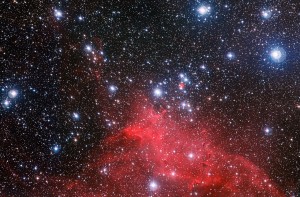Podcaster: Pamela Quevillon
 Title: Space Scoop: Roaring Fire of the Night
Title: Space Scoop: Roaring Fire of the Night
Organization: Speak Easy Narration
Link : http://speakeasynarration.com ; http://unawe.org/kids/unawe1373/
Description: Space scoop, news for children.
Bio: Pamela Quevillon is a voice actress who most often lends her voice to science and science fiction content. You can find her work on the “Escape Pod” and “365 Days of Astronomy”, as well as on her site
Today’s sponsor: This episode of “365 Days of Astronomy” is sponsored by — no one. We still need sponsors for many days in 2013, so please consider sponsoring a day or two. Just click on the “Donate” button on the lower left side of this webpage, or contact us at signup@365daysofastronomy.org.
Transcript: Roaring Fire of the Night
On 5th November every year, thousands of giant bonfires are lit all across the United Kingdom. This is a tradition to remember the night a man called Guy Fawkes was caught trying to blow up the UK parliament and kill the King, around 400 years ago.
Although the celebration of Guy Fawkes’ failure only takes place across the United Kingdom, the entire world can enjoy a similar sight this year! If you use your imagination, you can see a bonfire in this photo of the night sky, something that crosses all borders and is enjoyed by people of every culture! The red cloud plays the role of the roaring bonfire and the blue-white stars are the sparks shooting up from the flames.
In reality, this fantastic red cloud of gas and dust and the young stars scattered around it are all part of a star cluster called NGC 3572. Most stars are not born alone but in clusters, with many siblings born at about the same time, from a single cloud of gas and dust. They are almost the same age, but vary widely in size, mass, temperature and colour.
The lifetime of a star depends greatly on how big it is when it is born. A star fifty times more massive than the Sun will have a life of only a few million years, compared to the Sun, which will live for about ten billion years.
Stars much smaller than the Sun can live for trillions of years—much longer than the current age of our Universe. Because of this, star clusters like NGC 3572 provide astronomers with perfect laboratories for studying stars in various stages of their lives and learning how they evolve.
Cool Fact
Only around 10% of the cloud from which this cluster was formed will become stars. The rest of the gas and dust will gradually be blown away into space by the strong winds from these bright, hot, young stars.
End of podcast:
365 Days of Astronomy
=====================
The 365 Days of Astronomy Podcast is produced by the New Media Working Group of the International Year of Astronomy 2009. Audio post-production by Preston Gibson. Bandwidth donated by libsyn.com and wizzard media. Web design by Clockwork Active Media Systems. You may reproduce and distribute this audio for non-commercial purposes. Please consider supporting the podcast with a few dollars (or Euros!). Visit us on the web at 365DaysOfAstronomy.org or email us at info@365DaysOfAstronomy.org. In the new year the 365 Days of Astronomy project will be something different than before….Until then…goodbye.

